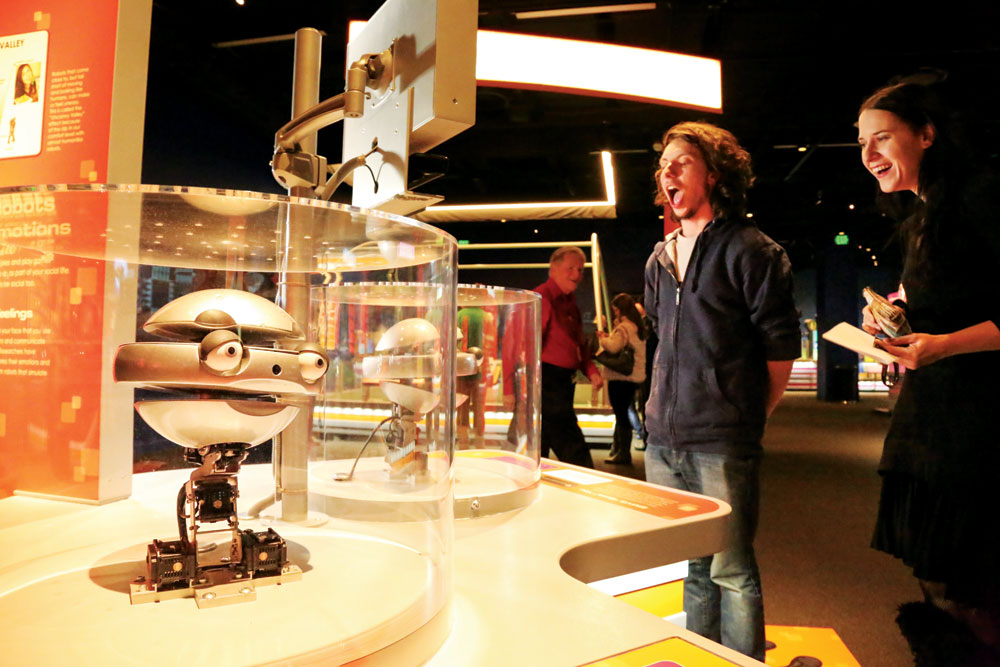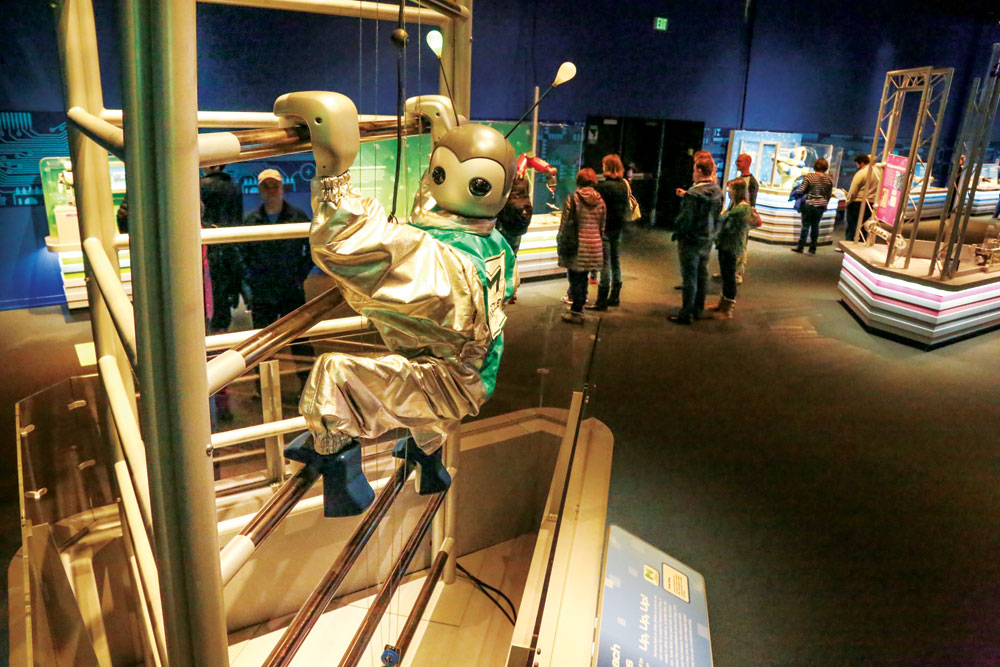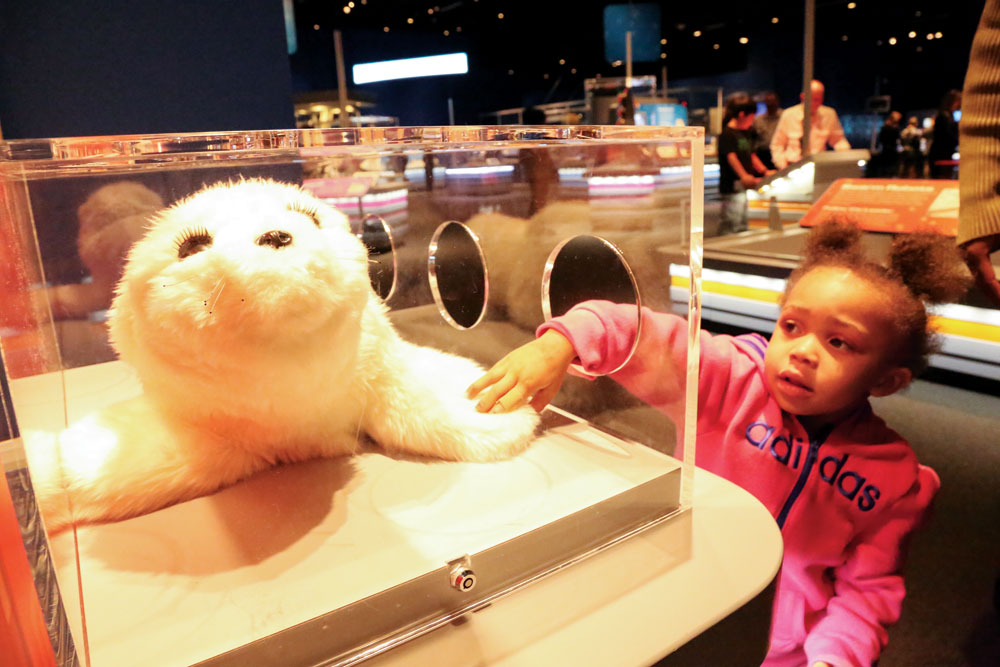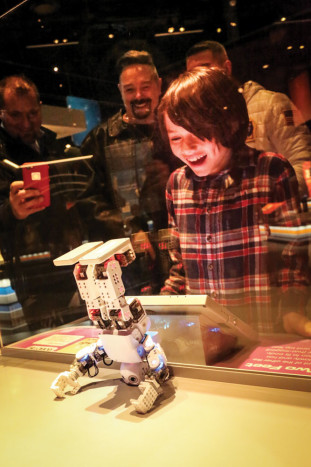
Taylor Kaiman, a chemistry student at CU Boulder, makes facial expressions that are picked up by a camera, causing the robot to imitate Kaiman’s expressions and the movements of his head. Explanatory information about this robot uses the term “The Uncanny Valley” to refer to the uneasiness humans may feel when they see robots expressing emotions.

Climbing robots like YUME ROBO can be programmed to do tasks like washing windows or even rescuing a cat from a tree. In the future such a robot may climb mountains on Mars.
Last year, I walked into an operating room and saw a few medical staff and one impressively large machine—the robot that would be performing my surgery—with a little help from the humans. Assured of its accuracy, fine touch and resulting faster recovery, I was cautious, curious and in awe. Just such a machine is on display at “Robot Revolution,” now showing at the Denver Museum of Nature & Science through August 7. Stroll around the large exhibit, which reflects robots from organizations around the world, and you’ll find yourself asking, “What’s the world coming to?”
“Robot Revolution” shows that what once seemed to be hypothetical and the stuff of science fiction movies is our reality. Brian Hostetler, educator for the exhibit points out, “If you think about it, cars that drive themselves are robots! They sense their environment, make a plan for how to navigate through it and have the ability to act upon that environment.” Another example, Roomba vacuums have been lightening the housework load for years.

Eli Wolf, 8, plays Tic Tac Toe with Baxter, a robot that can easily be programmed to do a variety of simple, repetitive tasks.
The exhibit, supported by Google.org with additional major support from The Boeing Company, is divided into four main color-coded areas: Cooperation, Skills, Smarts and Locomotion, all to introduce guests to the various aspects of robots.
“Cooperation” shows how engineering breakthroughs are helping create robots that work with humans to enhance our lives, such as the da Vinci Surgical System. EMYS uses a Facial Action Coding System to mimic guests’ faces and express basic human emotions. PARO shows the softer side of robots in the form of a furry therapeutic baby harp seal used to benefit the physical and emotional health of medical patients. And Soccer Robots make their way around a large soccer “field” using the same rules as human players, eliciting boisterous sideline coaching from the human observers.

Zenzel Cobb, 3 1/2, pats PARO, a harp seal robot that raises its head and opens its eyes in response to being stroked. Such robots have been used to soothe patients who can’t communicate well with other people, including people in nursing homes with dementia.

Owen Li presses buttons to direct ROBOTIS-MINI to do a variety of motions including standing on it’s head, walking, sitting and doing a karate move. It walks slowly and has big feet to keep it from falling down.
“Smarts” displays machines that are able to sense, plan and act. The humans get to see, compare and contrast how they do things compared to the robots like Baxter who plays tic-tac-toe against visitors. Yume Robo hoists his 60-pound frame up a ladder, coordinated by smart motors. “Skills” shows the things robots can do that mimic and sometimes surpass human capabilities by gripping and maneuvering and handling fragile and tiny objects. “Locomotion” explores ways robots can move, sometimes in places humans can’t or shouldn’t.
“Robot Revolution” offers interactive opportunities at every turn. Throughout the exhibit, there are ways to make the robots do things with just a glance or with the push of a button, such as Robotis Mini who can dance, take a bow and do headstands. Families can also participate in a live stage show about drones and their emerging capabilities. In the Tinker Tank section, people can build their own Snap Circuits using a variety of objects, play with Bee Bots or Cubelets and dress up in robot-inspired garb.
Hostetler reminds visitors that robots couldn’t exist without humans. “Without humans to build, program and maintain robots, they would not last long.” As proof, a repair shop of sorts is set up in the exhibit with large windows showing staffers surrounded by parts and tools.
Whether visitors approach “Robot Revolution” with trepidation or awe, Hostetler hopes the takeaway is that robots are here to stay. “They are all around us, and they are amazing! There are so many things that robots do for us in our daily lives. Embrace the revolution!”
“Robot Revolution” is a ticketed exhibition with pricing for members $7 for adults, $6 ages 3–18 and 65 and older. Nonmember pricing is $23.95 for adults, $17.95 for ages 3–18 and $19.95 for ages 65 and older. Tickets include museum admission. For more information, visit www.dmns.org/robot-revolution/.



0 Comments